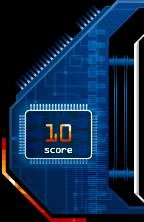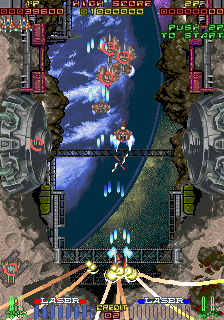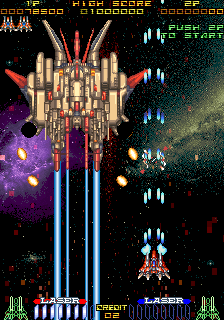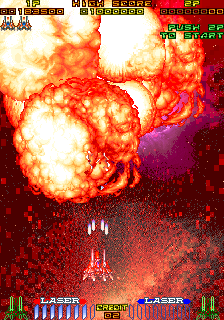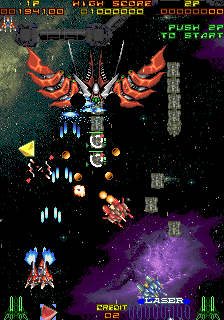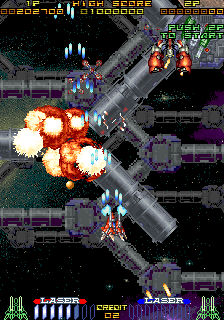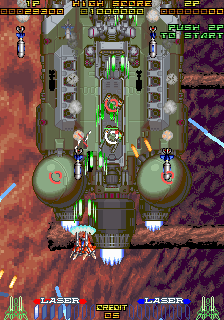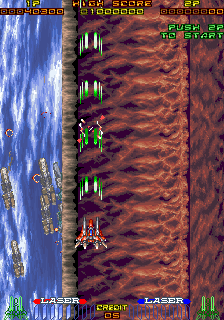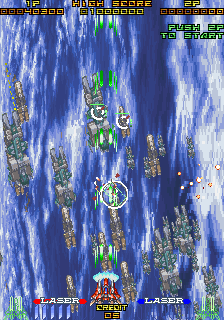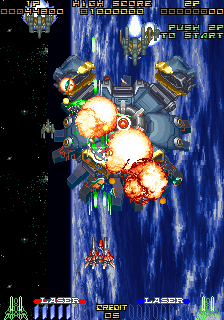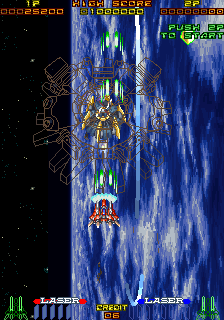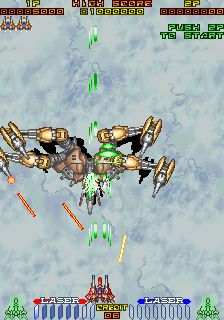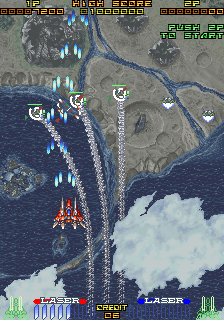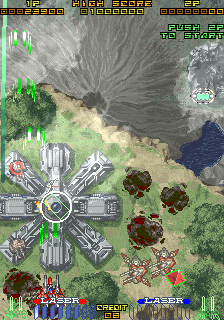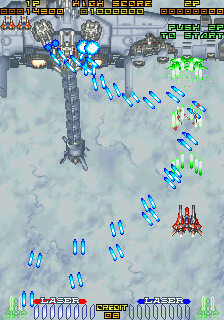|

Rayforce
(aka Layer Section & Galactic Attack)
Various
Systems (arcade/saturn) - Taito - 1993
Reviewed
by Randorama
There
are some games that never get old, or boring. It's a subjective
thing, of course. Sometimes you can still play a crappy game after
literally a decade it was published just because you liked it 10
years ago and you still love it, regardless of its objective quality.
In this case, I'm talking of one of the best shmups around, and
perhaps one of the 2 or 3 games that I'll still play, every once
in a while, until I'll grow old and bitter (ehm...). This game is
called "Rayforce" or "Layer Section" depending
on which version you get (I know, there was a lame US port whose
name was Galactic Attack, but its two original names are the aforementioned
ones).
THE
STORY (TRUST ME! IT HAS A PLOT!)
This
is basically the story of "Operation Meteor Strike". How
did it begin? The human governments, in a distant future, decide
to create a giant computer whose purpose is to administer the planet.
A
sort of giant A.I. system mantaining the balance of the ecosystem.
This computer,at some point, becomes fully aware and it goes nuts,
starting to clone at random human beings, killing people at random,
and destroying the ecosystem it's supposed to preserve, probably
because it realizes humankind watches too much tv (uhm, ok, it's
not very clear why it does it, i'm referring to the intro of "Raycrisis",
prequel to this game but third and final chapter of the series).
Now,
after killing 99.8% of humankind, the remaining fellows flee beyond
the moon, in outer space, to organize the final strike on the bad
"Con-human" (uh? What does it mean? "Contrary-human"?
like, pro (in favour of) vs con (contrary to)?Who knows...). This
final strike will resolve the conflict between humankind and Con-human...how?
We don't know - yet!
GRAPHICS:
10
The
game is one of the first Taito F3's games, a board which can perform
a lot of nice graphical effects like scaling: in fact, this effect
in particular is abused in the game (hence the name "layer
section").
The
practical aspect of this design is that you will see a lot of nice
scenes, like the beginning of the third stage, when you dive through
the outer strata of atmosphere, or the whole stage 6, when you cross
all the internal layers of the planet that divide the first inner
city (stage 5) from the second one (stage 7).The "layered"
graphics also mean that you have enemies scrolling below you that
can be destroyed by your super-cool homing lasers (a classicTaito
feature).
The
settings are also excellent: most of the time you will observe the
finely drawn backgrounds, like the floating islands in stage 3...
and then destroy the structures holding them, but be careful not
to get hit whilst gaping at the said isles falling down.
Most
of the graphics are indeed gorgeous, and the F3 board does indeed
a nice job in giving you a "3D" sensation: for example,
during the fourth boss battle, moving left and right on the screen
will make you see more or less of the sides of the canyon you're
flying on. The backgrounds and their design are very original: there's
a battle in a moon underground cavern (stage 2), then you enter
the atmosphere and you have these floating islands in stage 3, then
you can see the big mechas popping up from holes in the earth during
stage 4... at the end of the game, you see a crack in the earth
and you dive into it, to fight a big "mecha-spider" while
you're above the inner city.
This
inner city (stage 5) is what remains of the original "Con-human"
project: a vast underground civilization to shelter enslaved humans.
At the end of this stage, you fight a giant Mecha, Odin, the guardian
of the corridor that will lead you to the intermediate zone between
the TWO inner cities. Once you enter the second inner city (where
the important human beings, scientists mainly, were enslaved), you
are basically in the planet's core.
I
don't know how you are supposed to have cities there, perhaps the
nazis (or the gobligan empire from Mahou series) were right and
Earth is indeed hollow... Main thing is, your final battle takes
place at the centre of the planet, with the main baddie itself:
Con-Human.
If
the backgrounds weren't good enough, you can also appreciate the
splendid work on enemies' design: while most of the mecha/ship design
is based on classic anime and manga (or other classic games with
mechas), every enemy has a lot of details and shows a particular
attention put in their designing phase: For example, you can actually
observe the fine work done in the design of the legs of the fourth
boss (a sort of spider-mecha, hanging on the canyon I was speaking
of), or the nice animation of the fifth boss (called "Odin"),
which tries to literally slap you in one of its attacks.
The
two inner cities have also lots of details, in the first part of
stage 5 you actually fly over skyscrapers, then over to various
layers of fast-scrolling highways, in the artificial lit undeground
complex (parts of this city can be seen when mechas pop up during
stage 4 from "fissures"). Since we're speaking of mechas,
we can easily say that the game predates, in design, various Aleste
games, and many other sources, as can be easily seen in the pics.
As i told you before, you even get the big mecha boss as the end
of fifth stage, as the guardian of the inner core. This game also
sports a nice variety of typical taito bullets: in case you didn't
live on Mars or in another dimension, Taito is known for their fetish
with homing lasers (the ones who will stop for a while and then
ram at you, and weird bullet forms...In fact, we have the oval-shaped
bullets too, the small flashing orange ones, big lasers, double
scaling lasers from tanks, and other nice attacks, whose originality
always made me smile (except when they hit me, !"£!@").
Speaking
of colour, the game is very well coloured, even if it tends to dark,
or pastel-like, tinges, especially in the subterranean stages (but
that it's to be expected, after all), which actually are a good
apportation to the game's dark atmosphere. Now,two words on the
port:The Saturn version is a bit more pixelated than the original
one, i checked a video taken from the original board and my Saturn
copy (it's something you can note ONLY if you put side by side the
two versions and you're not playing, and you can mind it only if
you buy games for "eye-candyness").
SUMMARY
OF SUB-SECTION.
The
game exploits the hardware it runs on at full power - you will see
lots of scaling sprites, excellent designed enemies, and excellent
backgrounds. Its settings conjure up a dark and brooding atmosphere,
and also implement the hardware abilities and the plot in a flawless
way.
SOUND
AND BGM: 10
This
game has, in my opinion, the best BGM composed by Tamayo Kawamoto.
Tamayo Kawamoto is a good-looking lady that started working on Capcom
and made classics like Black Tiger(1987) and Ghouls'n Ghosts (1988).
Both games featured dark fantasy settings, and Ms. (Mrs.?) Kawamoto's
compositions were perfect for both.
In
1988 she left Capcom and went to Taito, to found Zuntata sound team.
From what i know, her first solo work is indeed Rayforce, and i
have to say that it's also her best one. The BGM is mostly what
i would call "progressive techno", even if people who
know more on the genre may have better and more precise definitions.
Basically it's a sort of dancey/ambient soundtrack with a quite
brooding and dark feel, which blends in a perfect way with the dark
atmosphere of the game.
I
think it's also the first shmup featuring a dance/ambient BGM, something
that's a standard in these days. As i told you,the BGM is truly
great, but one caveat to be done is this: The Saturn port has remixed
songs, and the original BGM wasn't ported.
I
think this is a very dumb move - i mean, wtf, it's ok, you wanted
to offer something new, but let me choose,ok?! And don't tell me
you hadn't enough space on the f!"£ing CD! Bah, Taito
are freaks...Still, the remix songs are more or less better than
the arcade version, quality is a bit superior, but mainly the songs
have just received minor "tweaks", aside the second stage
one (whose name is simply "2G"), which has some 30 extra
seconds at the beginning.
A
couple of memorable songs are "Into darkness" (stage 5)
and "Quartz" (second part of stage 7), the former for
its very dark mood, the latter for its slow and quite sad refrain.
The aforementioned "2G" has also a trancey mood, like
"Cracking!",the fourth stage theme. Boss themes are also
great,especially the second one, "Atrocity " (stages 5,6),
not to mention "agressiveness" (stage 1,2,3,4) and "the
fates", the final orchestral theme (and its second part, "Doomsday").
The
best example of the exquisiteness of the soundtrack is the first
song, "Penetration", which at once defines its progressive/trance
nature and provides the stage with a nice and fast "futuristic"
theme, perfect for the pure, "hard" sci-fi setting. It's
actually nice to listen them back after 10 years, because they sound
a bit retro, with their mid-90s flavour... But you can't really
resist "On Standby", perhaps the best "attract mode"
song ever, with its simple and hypnotic loop,almost like a minimalist
piece. One final note: while i never figured it out fully, it seems
there's at least one remix album of the soundtrack, featuring even
reggae remixes of the various songs!
SUMMARY
OF SUBSECTION
The
BGM is Tamayo Kawamoto's masterpiece, and it conjures up perfectly
the dark,brooding atmosphere of your fight against impossible odds,
entering the viscerae of Earth. It also sets the standard for the
shmups genre - meaning it's the first dance/ambient BGM ever, and
one of the finest. The Saturn version has slightly different songs
though, but Taito omitted to put both versions on the port, I wonder
why...
GAMEPLAY:10
The
game is basically Xevious on steroids. Said that, the (check URL)
ST covers this aspect in detail. You only have two weapons: forward
shot and lock-on lasers. Your main shot can be powered-up in two
ways: red pods (you need three of them to increase your shot level)
and yellow pods (one pod, one level). It only hits enemies on your
plane, and is pretty powerful from level 4 on.
Your
second attack is the lock-on laser system. This attack takes advantage
of the pseudo-3d enviroment and works in this way: you have a grid
in front of your ship that lets you lock-on lasers on enemies below
you. Once you pass this grid on those enemies, they will be locked-on
until they will go completely out of the screen. You start with
five lasers at your disposal, and can get up to eight thanks to
the "L" item. Lasers are basically more powerful than
the normal shot, but since they can be only used on enemies below
the main plane, you can't rely on it in every occasion.
Lasers
are also the key to big scores: if you can lock-on multiple targets,
you will receive a multiplier on basic points value:
first laser: x1
second laser : x2
third laser: x4
fourth laser: x8
fifth laser: x16
sixth laser: x32
seventh laser: x128
eighth laser: x256
As
you can see, the true key for big scores is getting 7 or 8 lock-ons
at once (not easy to do, of course!). For example, if you can destroy
an enemy (of course, partial hits won't count,you get the multiplier
only if you destroy the enemy with that laser) that's worth 800
points with your eighth lock-on, you get 800x256=248k points!
Another
important feature is the rank system: basically, the more time you
survive,the harder the game gets. Also, once you extend, you get
another increase of rank, and this means that Saturn players are
penalized: the original arcade version gives you two extra lives
at 1M and 2M, Saturn version at 500k and 1M (thus giving you the
extra increase in ranking earlier in the game).
Please
consider that rank in this game is FIERCE, it maxes out pretty early
(by third boss if you never die) and the game basically turns into
a "manic" shmup.
Some
notes on enemies: except for stage 1 and 5, every stage has a mid-boss
(uhm, only the sixth mid-boss effectively appears at roughly half
of the level...), and all boss battles are done in the Taito way:
most of them are quite long, especially if you want to place the
score-rewarding blow, and most attacks are based more on safe spots
and tricks than pure dodging skills... After all, your ship's collision
area is pretty big, a square that leaves out wings and cannons,
more or less.You will also need to learn some patterns of aerial
enemies at some point, especially when the difficulty will be quite
high, because most of them, at this point, not only shoot a lot,
but will also like to ram at you: Ican't think of a game where you
have more chances to get killed by collisions.
Finally,
one note on 2 player mode: you only have four lasers per player
(starting at 3),so you're limited in score and "offensive freedom":
a way to to basically "invite" players to cooperative
shmupping?
SUMMARY
OF SUBSECTION:
The
game's mechanics are a modern form of classic like Xevious, and
they feature a forward shot and a lock-on laser that will destroy
enemies on planes below you and reward with exponential scores if
you do multiple lock-ons at once. The game has a rank system based
on survival, extra lives in stock and number of lasers used, that
will force you to deal with quite difficult enemies at some point
(if you play well).
LONGEVITY:9-
I
think I will probably avoid giving votes higher than a "9++"
to most shmups, regarding the longevity aspect.
This
mainly because most of shmups feature a pretty unique gaming system,
which is a bit of an handicap if you want to play them again after
a while. Also, this game has a pretty simple port, lacking a few
extras that could have made it better, like score attack/boss attack
modes. Even if these are very minor issues, you may try a few runs
before getting used again to its system, once you haven't played
it for a while.
This
is also a small handicap: you can actually enjoy a quick run, every
once in a while, if you don't mind the score.The strength of this
game is its uniqueness: it's simple and quite complex at the same
time, and even if you just mind "eye-candyness" (and most
people surely do: let's be honest, would you play a game with a
great gameplay system, and just decent gfx? I've done it, but i'm
probably an exception to the rule), you can't simply resist its
layer-based design...
The
game, by the way, is also quite a challenge to complete on one credit.
Rank makes the game quite more difficult, the better you play: after
all, it's the purpose of this system. Let's not forget,too, that
the hit area is big, compared to modern standards, and this will
require some time to get used to. You also don't get any extra ships
or other options: as Isaid, the game is pretty simple, and heavilly
score-oriented.The absence of a smart bomb feature also forces you
to get confident with levels: most of the time you can find yourself
dodging tons of bullets from below and in front you because you
didn't destroy at the proper time enemies, and most of the time
this will mean death.Bosses are also quite though, especially if
you aim at score: even the first one has a lot of attacks, and they
all have a lot of stamina.
As
i said, being this a Taito game, you can expect long and difficult
( but quite rewarding,once you learn to do them) boss-fights: shame
they didn't make a boss attack mode, it would have been funny to
fight at will bastards like Odin. One final summary on the Saturn
port:it's a pretty simple conversion. You get a remixed BGM instead
of the old one,slightly more pixelated graphics,a tate mode, and
a easier default difficulty (please put it at "Hard 2"!).
SUMMARY
OF SUBSECTION:
The
game is a good challenge, especially if played for score, and has
a good replay value, even if the casual play done every once in
a while may need some "tuning",due to its pretty unique
system.The Saturn version is a bit easier, but difficulty can be
increased.Sadly, you don't get any extra modes, so it's basically
the simple game and that's all.Still, after all these years,an excellent
and innovative game.
FINAL
VOTE AND REMARKS: 10--
Rayforce
is a splendid game that features gorgeous graphics, an excellent
BGM and an awesome game system. It's simple and complex at the same
time, since it's easy to learn and difficult to master.The game
is usually pretty cheap to buy, and thus is absolutely a must-own
in the collection of any serious shmupper.One of Taito (and shmups
genre) finest games ever, that's for sure ;)

|







